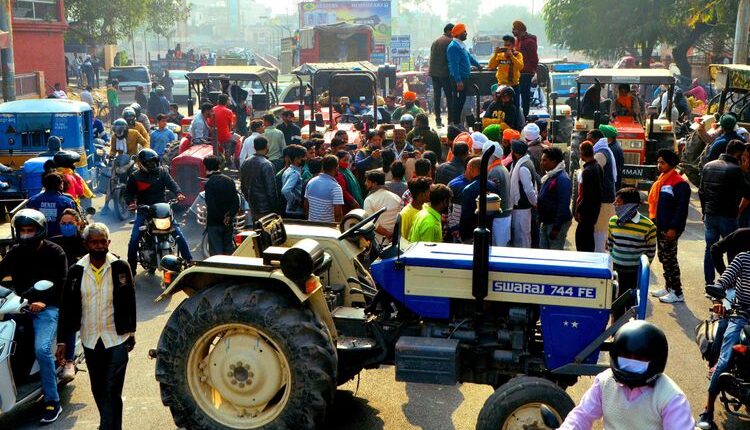
Farmers protest: Great Indian democracy in action
This story first appeared in Gulf News
Issues faced by farmers are so diverse that it’s hard to have a coherent list of demands
The Indian streets have come alive ever since Narendra Modi became the Prime Minister in 2014. Now and then, street-level agitation challenges the Modi government.
Suhas Palshikar, one of India’s most distinguished political scientists calls it “the energy of non-political parties” in the society.
At a time when the mainstream opposition Congress and regional parties are failing to articulate the concerns of the people, this new wave of the protests, backed by the aggressive use of social media, is challenging the establishment.
Palshikar notes, “BJP handles the street agitation in calculated manner.” The government’s critics claim the BJP’s aggressive ‘campaign machine’ is making difference on the ground. Palshikar alleges, “BJP stigmatises their opponents and weakens the street movements.”
The massive uproar against the Land Acquisition Amendment bill (2015) was a success and the government had to dump the proposed amendments. In Maharashtra two street protests against the BJP-led government created national empathy. The Marathas had hit the streets demanding the reservation and the huge demonstrations of Dalits in Bhima-Koregaon in 2018 made a national impact. But, the most memorable has been the countrywide stir against Citizenship Amendment Act (CAA) of 2019. Some of Modi government’s most staunch critics came together even as the anti-CAA agitation evoked images that went international.
The ongoing agitation of farmers, largely Sikhs and Jats of Punjab-Haryana, at the borders of Delhi against three agriculture produce related bills is witnessing extraordinary confidence of agitators.
Getting their voice heard
Apoorvanand, noted educationalist and intellectual, who himself has hit the streets many times in the past says, “Visiting the struggling farmers I didn’t find any protesters depressed. None is having the fear of Covid. There is camaraderie with the local population. That tension which was visible during Shaheen bagh (anti-CAA protests) isn’t present here. They won’t go back home without getting their voice heard.”
Adds Harish Damodaran, Agriculture Editor of Indian Express, “The farmers agitation is manifestations of humiliation and frustrations over the years. Its just not about the three new farm laws out of which two are harmless, actually. Mandis are dear to the farmers and they are feeling insecure about its future due to the new laws.”
More than 35 farmer unions and more than 18 political parties supported the countrywide strike on December 8 to express solidarity with Punjab-Haryana based farmers.
Shekhar Iyer, senior journalist says, “Those who have not been able to defeat the Modi regime through the elections are hitting the streets. It’s obvious that they don’t represent all sections of the society.”
Talking about the frequent street politics in the Modi era Apoorvanand claims, “BJP government has politicised average people like no other!” There is a feeling however that street protests against the Modi government are not having any real success. “A major difference has taken place since 2014. All street protests are matched by the counter-protests. This is a new phenomenon,” claims Apoorvanand.
Poorly drafted laws
But, it’s not easy to counter the farmer’s agitations. As the journalist Damodaran points out, “This farmer’s agitation is different than most recent agitations. It’s not easy to mobilise India against farmers. The counter-agitation against “annadata” in India can be counterproductive. The government has no option but listen to the farmers. The new laws are poorly drafted and passed in haste. The farmers are unlikely to go home without getting something in the bargain.”
Street politics keeps democracy alive and it is a leverage people create for themselves to negotiate with the government but sometimes the end result may be confusing.
The government did feel the heat during the CAA agitation, but the opinions are divided over the actual outcome.
This unprecedented release of creativity in forms of slogans, stand-up satires, graffiti, musicals and write-ups seen during the Shaheen baug agitation against the government may have actually helped the BJP to build-up of the counter-opinion. Many observers believe that the CAA accelerated polarisation which always helps the BJP.
Apoorvanand claims that the political, economic or social issues in the “fractured society” will not be of the “common interest” and that would eventually make the street agitation dull.
In absence of the validation of all sections of society the government remains unaffected, largely, he argues.
He says, “the Sikh farmers agitation has created curiosity but the “majoritarian attitude” developed under the Modi government isn’t allowing the farmer’s agitation to emerge as the “all people’s movement.”
Success of street level agitation?
A senior BJP leader and himself a farmer told Gulf News, “The street politics can succeed only if its based on social values. You have to hit the street for common good. What is the social values the farmers’ are fighting for? What will be the addition of the social value to life of farmers? We believe without a strong emotion binding the people, street level agitation can’t succeed.”
The problem with the current agitation is that the Indian farming sector and the issues faced by the farmers are so diverse that it’s difficult to have one coherent list of the demands. Palshikar concludes, “For larger politics, numbers are required. Without the numbers on their side, no street fights can win the battle.”
The farmers agitation on the Delhi borders would gain something for sure. May be the new farm laws are tweaked. There is less chance that it would be annulled. Whatever the outcome, one thing is for sure: the great Indian democracy is in action here and there is nothing called ‘too much of a democracy’.
Link to original story
